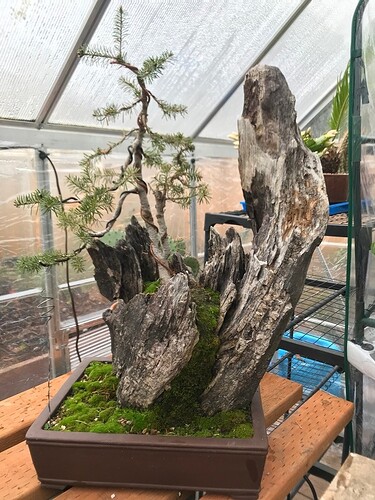Anyone have a good source for ordering keto? would love some help sourcing for rock/forest plantings this spring. thanks!
I don’t know of any resource other than googling it and seeing what comes back. I was able to make a successful mixture using Steer Manure, field clay,Akadama fines, Long Spagnum, and worm castings that held together, didn’t shrink or crumble to support the below tree on stump composition. components listed in order of volume – probably 40% manure, and decending from there mixed with water until it held its shape when squeezed, but not dripping.
the “Keto” mix was used down the front to connect the pocket at the top and the pot below. after getting the roots layered in with the mixture, i pressed top dressing into the Keto with a chopstick to imbed the dressing and it mossed up in about 3 months to what you see in the photo.
Hi @Kellogg. Where abouts are you based. In the UK there are a number of suppliers. Ryan did a stream on muck creation. Haven’t watched it yet but I’m sure it could help.
same as Keith, well depends on where you live.
Austin Texas, just haven’t been able find anything on the internet from any bonsai suppliers.
I guess I didn’t mention that I too wasn’t able to find a source for Keto in the US (i am in WA.) so i ended up making some, which worked great and is still going strong a year later. I found this site, but based on the components i thought i could do better.
https://bonsailearningcenter.mysimplestore.com/products/super-muck-for-bonsai
Jason
For those within Europe Maarten at Bonsai Plaza is a great supplier. His fair European postage costs make buying bulky items easy and he has keto. https://www.bonsaiplaza.com/en/
thanks for the website! might have to give the bonsaiplaza keto a try. looks similar from what i can see to the bag ryan uses in his muck creation video.
Hey there, I was wondering if you wouldn’t mind listing the components you used to create your keto? Besides the use of peat moss and sphagnum moss.
The small bags are lovely and sticky but more expensive for the volume you get. I have used the large bag for ‘walls’ on slabs and the sticky stuff for planting on tall rocks.
I used about 40% Steer Manure, with a mix of Akadama dust(the sifted fines), field clay, long sphagnum, and worm castings mixed in. I would say it was equal parts aside from the steer manure. I would suggest pre-soaking the moss, and the clay was easier to mix in if it was dry/crumbly to start. the worm castings were probably not key, but i felt they lightened the mix. Peat moss might fit the bill as a substitute.
Once it was all mixed together i added a little water at a time until it would hold together, without being able to squeeze more than a drop or 2 out of the mix in a clenched fist. in the heat of the summer there was minimal shrinkage, never crumbled, and would accept water quickly, even on the vertical surface.
All in all it was something i would use again without any adjustments.
hope that helps!
Jason
Thanks for the info will definitely look into it more.
Superfly bonsai… Muck-O Bonsai Muck Keto Soil For Making Kokedama, Kusamono and Seki-Jo – Superfly Bonsai
Wisco muck from Wisconsin. https://www.wiscobonsai.com/product-page/wisco-muck this one has fired clay fines.
I use the silt from a silt containment pond in my back yard and add sphagnum moss in large clumps to bind it together. The secret ingredient is the fines I sift from my akadama, lava, and pumice. So I have many soil components to make the mix. Important to not break up the sphagnum so the fibers are interlinked to give stability. I have been able to grow moss on the muck dams which keeps the moisture and air going through the substrate.
necessities are drainage, moisture retention and structure retention. ![]()
learn lots, share with others, have fun!
